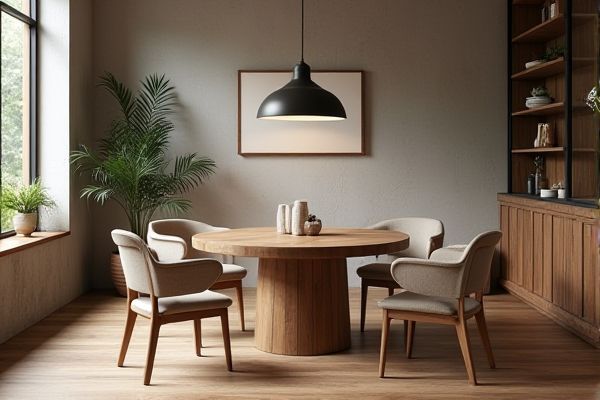
Plank tables offer a sturdy, elongated surface ideal for maximizing seating and creating a classic dining atmosphere, while round tables promote more intimate and inclusive conversations by eliminating sharp corners and encouraging equal interaction. Discover which table shape best suits Your space and lifestyle by exploring the detailed comparison ahead.
Table of Comparison
| Feature | Plank Table | Round Table |
|---|---|---|
| Shape | Rectangular or elongated plank shape | Perfectly circular |
| Seating Capacity | Typically seats 6-12 people | Usually seats 4-8 people |
| Space Efficiency | Requires more linear space | Maximizes space usage, fits smaller rooms |
| Interaction | Less face-to-face interaction in long tables | Encourages equal and direct conversation |
| Style | Rustic and modern blend, natural wood grain emphasized | Elegant, contemporary, and classic styles |
| Use Case | Ideal for dining rooms and conference tables | Perfect for small gatherings and casual dining |
| Stability | Typically stable with sturdy legs or trestles | Even weight distribution ensures stability |
Introduction: Plank Table vs Round Table
Plank tables offer a rustic, elongated surface ideal for maximizing seating capacity and showcasing natural wood grain, making them a centerpiece in dining rooms or conference spaces. Round tables promote equal social interaction by eliminating head positions, enhancing conversation flow and space efficiency in smaller rooms. Choosing between plank and round tables depends on the desired aesthetic, room size, and social dynamics.
Design and Aesthetic Differences
Plank tables feature long, linear surfaces that emphasize natural wood grain patterns and offer a rustic, farmhouse appeal suited for modern or industrial interiors. Round tables promote inclusivity with their circular design, enhancing social interaction and complementing spaces that favor fluid, organic shapes and minimalist aesthetics. The contrast in form between plank and round tables influences spatial dynamics, with plank tables aligning well along walls or in rectangular rooms, while round tables optimize flow in tight or multi-purpose areas.
Space Efficiency and Room Layout
Plank tables maximize space efficiency by offering a narrow, rectangular surface ideal for fitting against walls or in tight dining rooms, allowing for easier placement of chairs along the length. Round tables excel in facilitating traffic flow and social interaction, as their shape eliminates sharp corners and promotes equal seating arrangements, making them well-suited for compact or awkwardly shaped spaces. Room layout benefits from plank tables in linear or narrow rooms, while round tables enhance flexibility and movement in square or multi-purpose areas.
Seating Capacity and Flexibility
Plank tables typically offer greater seating capacity along their elongated sides, accommodating larger groups efficiently for meetings or dining. Round tables promote equal seating flexibility, encouraging interaction and conversation by eliminating head positions and allowing easy access from all sides. Choosing between the two depends on the specific spatial layout and the desired level of social engagement within the environment.
Social Interaction and Conversation Flow
Round tables promote equal social interaction by allowing everyone to face each other directly, enhancing eye contact and inclusive conversation flow. Plank tables create a linear seating arrangement, which can limit engagement between individuals seated at opposite ends and often leads to segmented discussions. For dynamic discussions and collaborative environments, round tables typically offer a more connected and interactive experience.
Stability and Durability Comparison
Plank tables offer superior stability due to their broader surface area and reinforced leg structures, minimizing wobbling on uneven floors. Round tables distribute weight evenly across all sides, enhancing durability by reducing pressure points that can cause material stress over time. Both designs utilize high-quality hardwoods to maximize longevity, but plank tables typically withstand heavier loads better, while round tables excel in maintaining consistent structural integrity.
Ideal Use Cases for Each Table Shape
Plank tables are ideal for long dining rooms or conference areas where maximizing seating and clear sightlines are essential for group interactions. Round tables promote more inclusive conversations by allowing everyone to face each other directly, making them perfect for intimate dining settings or collaborative meetings. Choosing between plank and round tables depends on space constraints and the desired level of social engagement in the environment.
Maintenance and Cleaning Considerations
Plank tables often require regular sealing or oiling to maintain their wood finish and prevent damage from spills, while round tables with smoother surfaces generally need less frequent maintenance. Cleaning a plank table involves careful attention to grooves where dust and debris can accumulate, whereas round tables allow for easier wiping and quick cleanup. Your choice depends on whether you prefer the rustic charm of a plank table with its upkeep or the low-maintenance convenience of a round table.
Cost and Material Availability
Plank tables often cost less due to the use of readily available, standard-sized wooden planks, making them budget-friendly and easy to source from local suppliers. Round tables, typically requiring custom cutting and higher-grade material for uniform curvature, tend to be more expensive and rely on specific wood types or composites that may be less accessible. Your choice will impact both the upfront cost and the ease of sourcing materials based on local market availability and woodworking requirements.
Which Table is Right for You?
Choosing between a plank table and a round table depends on your space and lifestyle. Plank tables offer a sturdy, rustic aesthetic and accommodate more people in a linear arrangement, making them ideal for longer dining rooms or workspaces. Round tables, with their smooth edges and ability to promote conversation, suit smaller spaces and encourage social interaction, so your choice should reflect how you use your space and the ambiance you want to create.
 homyna.com
homyna.com